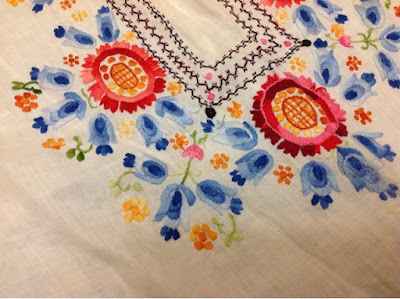Some of you already know this, many of you may not, but I've been very VERY slowly working on a Certificate of Fashion Design online. This involves lots of drawing, something that I thought I was pretty decent at. Until I took this course. My first real drawing assignment was figure drawing, a standing and seated pose. I'd post the pictures but they are a tad wonky... however... surely I think I did better than the 69% I was given! I'm sure I'm a bit out of practice, but for those of you who know me, 69% is not acceptable. In fact, I was the type of kid who cried if I got less than a 90%! Well, college did a good job of beating THAT out of me, however my cutoff was and still is still an 80%. Needless to say I was a tad disillusioned by this unfortunate 69%.
The second assignment I did a bit better. We had to design two outfits for women and two for men. Just line drawings, no color. I got an 80%, which is technically ok with me, and I got some really nice comments. So considering the previous assignment I was pretty happy!


In the following module, we had to learn about different body types and how clothing can be used to flatter and alter the appearance of your natural shape. Then we had to design an outfit to flatter each of the four basic body types, and write a paragraph about how the outfit flatters that shape. I was a little worried about this project, but I'm happy to say I nailed it! I got a 90%, which is great in my book, especially for this course! I got some very nice comments too! So here is a little mini lesson on how to flatter the four basic body types:
 The Rectangle
The RectangleThe rectangle body shape is characterized by very little difference between the width of the shoulders, waist, and hips. The goal of dressing this body type is to create the illusion of an hourglass figure by making the waist appear smaller and hips/shoulders appear wider. The outfit above has a wide neckline and bloused bodice which makes the shoulders appear broader and bust appear larger. The cinched waistline makes the waist appear smaller and by ending the shirt along the hipline, the hips appear fuller. Soft touches like the floral butterfly fabric, scalloped hems, jewelry, and bright heeled shoes add a sense of femininity to this boyish figure.
 The Pear
The PearThe pear body shape is characterized by narrow shoulders, generally smaller bust, narrow waist and large hips. The goal of dressing this body type is to play down the emphasis on the lower body and add balance to the upper body. The outfit above has a structured jacket in a light color, making the upper body appear fuller and shoulders broader. Details like front pockets, a strong collar, and large buttons keep the eyes interested and focused upwards. Ending the jacket at the waistline emphasizes the small waist. Straight-leg pants give balance to a larger bottom, and the dark pinstripe fabric makes the bottom appear smaller and legs appear longer. Simple heeled shoes also help elongate the legs.
 The Inverted Triangle
The Inverted Triangle
The inverted triangle body shape is characterized by broad shoulders, generally larger bust, and narrow waist and hips. The goal of dressing this body type is to play down the emphasis on the larger upper body and add balance to the lower body. The outfit above has a simple fitted top in a darker color which makes the upper body appear smaller. A scooped neckline is also more flattering to a larger bust. The flared skirt in a lighter floral pattern draws the eye to the lower body and makes the hips appear fuller. Details like pockets, topstitching, and a large scalloped hem keep the eyes focused downward. Adding an unexpected pair of matching cowboy boots keeps the look casual & fun, and shows off the great legs usually associated with this body type.
 The Hourglass
The Hourglass
The hourglass body shape is considered ideal and is characterized by balanced shoulders and hips and a small defined waist. The goal of dressing this body type is to simply accentuate the natural shape. However, this shape can easily lean towards a pear or inverted triangle if too much focus is placed on one part of the body. The outfit to the right has a fitted top in a soft wave pattern that accentuates the natural curve of the body. The draped neckline places a touch of emphasis on the bust/shoulders while ending the hem above the widest part of the hips keeps the hips from looking too bulky. The boot-cut pant leg balances the wider hips. Heeled shoes in a matching color make the legs appear longer and keeps the eyes from focusing on only one area of the body.










































